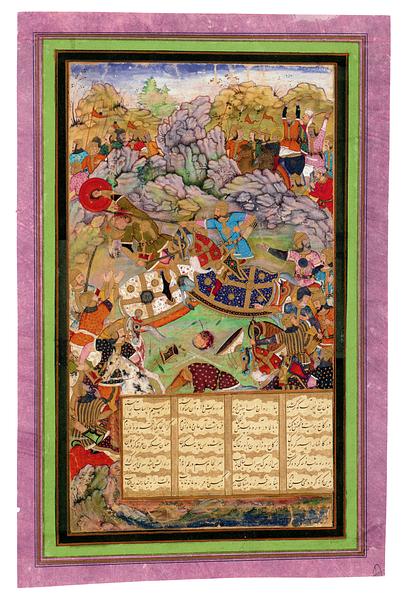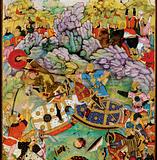Miniature from a copy of the Baburnama, pasted on an album leaf. ‘Babur is Struck on the Head by his Cousin Sultan Ahmad Tambal’
India, Mughal; c. 1590
Leaf: 37.6 × 24.4 cm
The Great Mughals, who were descended from both Genghis Khan and Timur and came from Central Asia, took pains to legitimize their right to rule India through historical writings. The first Great Mughal, Babur (1526-1530), wrote his autobiographical Baburnama, in Chagatay Turkish. His grandson Akbar had it translated into Persian and commissioned his court artists to illustrate several editions of it.
In a typical mixture of a stylized Persian view of nature and grim Indian realism, this miniature illustrates an episode from Babur’s early past in Central Asia. He is about to lose his life in one of the period’s many dynastic struggles when he is dealt a crippling blow from his cousin Tambal’s sword.
Inv. no. 29/1980
Published in:
Sotheby’s, London, 7/4 1975, lot 98;
Spink & Son: Islamic art from India, London 1980, cat.no. 61;
Ellen S. Smart: “Yet another illustrated Akbari Baburnama manuscript” in Robert Skelton, Andrew Topsfield, Susan Stronge, Rosemary Crill (eds.): Facets of Indian art : a symposium held at the Victoria and Albert Museum on 26, 27, 28 April and 1 May 1982, London 1986, pp. 108, 115, and note 12 (only mentioned, no photo);
Kjeld von Folsach: Art from the World of Islam in The David Collection, Copenhagen 2001, cat.no. 64;
Kjeld von Folsach: For the Privileged Few: Islamic Miniature Painting from The David Collection, Louisiana, Humlebæk 2007, cat.no. 70;
Kjeld von Folsach, Joachim Meyer: The Human Figure in Islamic Art – Holy Men, Princes, and Commoners, The David Collection, Copenhagen 2017, cat.no. 43;


